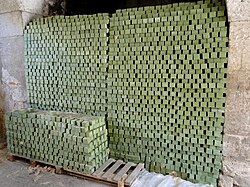NHK / NEW YORK TIMES
輝達美西時間18日於年度盛會「GTC 2025」宣布,推出全新AI平台Blackwell Ultra,市場引頸期盼的GB300系列晶片同步亮相,主打比GB200效能提高1.5倍,擴大搶攻AI推論、代理型AI與實體AI等熱門商機。
輝達AI晶片戰力再升級,再次打造「地表最強AI晶片」,業界預期仍由台積電(2330)操刀代工。鴻海、廣達、英業達、緯創、華碩、和碩等台廠第一時間即高喊加入打造GB300 AI伺服器行列,預計今年下半年開始出貨,跟著輝達搶食新一波AI大商機。

輝達執行長黃仁勳表示,AI發展突飛猛進,推論及代理型AI需要比當前高出數個量級的運算效能,而Blackwell Ultra就是為此所設計,可輕鬆高效執行預訓練、後期訓練與AI推論。
輝達指出,Blackwell Ultra適合代理型AI應用,可自主解決複雜的多步驟問題,讓AI代理系統不只是聽從指令行事,還可推理、規畫並採取行動,達成特定目標。
在實體AI應用方面,Blackwell Ultra能即時生成合成的逼真影片,用於大規模訓練機器人和自駕車等應用情境。
輝達強調,Blackwell Ultra延續以Blackwell架構為建置基礎,包含GB300 NVL72機架解決方案與HGX B300 NVL16系統。
輝達提到,GB300 NVL72連接72顆Blackwell Ultra GPU與36顆安謀Neoverse架構Grace CPU,其AI效能比GB200 NVL72提升1.5倍;與基於前一代Hopper架構的產品相比,Blackwell在AI工廠市場的營收機會提升50倍。
輝達同步推出AI超級運算系統DGX SuperPOD,使用GB300 NVL72機架設計,可提供客戶一站式AI工廠。當中DGX GB300系統搭載機架級液冷式架構,氣冷式DGX B300 系統則採用B300 NVL16架構。
輝達指出,相較於Hopper架構世代,HGX B300 NVL16在大型語言模型上的推論速度提升11倍、運算能力提升七倍、記憶體容量增加四倍,可為AI推理等最複雜的工作負載,提供劃時代的效能。
輝達表示,預計自今年下半年起,合作夥伴包括Aivres、華擎、華碩、鴻海集團、技嘉、英業達、和碩、雲達科技、緯創與緯穎、思科、戴爾、慧與科技、聯想與美超微等公司,都將推出各種搭載Blackwell Ultra產品的伺服器。
另外,雲端服務供應商亞馬遜AWS、Google Cloud、微軟Azure與Oracle雲端服務等,也將率先提供Blackwell Ultra驅動的相關服務。
華碩、技嘉、微星三大品牌廠同步釋出AI伺服器新品,其中,華碩與技嘉皆推出搭載輝達GB300的最新產品,微星則亮相基於輝達MGX架構的4U與2U AI伺服器平台。華碩在GTC大會活動中發表搭載輝達GB300 NVL72的ASUS AI POD,同時宣布已獲得關鍵訂單。
延伸閱讀
VISUALIZATION/GAMIFICATION
- the application of typical elements of game playing (e.g. point scoring, competition with others, rules of play) to other areas of activity, typically as an online marketing technique to encourage engagement with a product or service."gamification is exciting because it promises to make the hard stuff in life fun"
Translation results
Translation result
特別篇:創造血管!心臟衰竭患者的救命移植手術
科學觀點
一種治療心臟衰竭的全新方法。透過完成八次臨床試驗手術,我們探索了大阪大學使用 iPS 細胞衍生的心肌細胞移植的突破性方法。
“It’s an overnight success years in the making because he captured A.I.”
該公司成立於 1993 年,兩年內其年利潤增長了 1,500% 以上,從 2023 財年的 43.7 億美元增至去年的 728.8 億美元。
「詹森已經成為了他一直想成為的明星首席執行官,」拉奧先生說。 “這是多年來一夜成名的經歷,因為他掌握了人工智慧。”
Nvidia Is Hosting the Super Bowl of A.I.
The giant chipmaker has transformed its annual developer conference from an academic event into a who’s who gathering for the future of artificial intelligence.
Nvidia 將舉辦人工智慧超級碗
這家晶片製造商巨頭已將其年度開發者大會從學術活動轉變為人工智慧未來的名人聚會。
黑色牛仔褲的黃仁勳站在舞台上,旁邊有一個小型機器人。
Nvidia 執行長黃仁勳出席公司 2024 年年度開發者大會。

“Nvidia makes the chips that are oxygen for A.I., so people are on their toes to learn about their latest and greatest,”
“Nvidia 生產的晶片是人工智慧的氧氣,因此人們都在密切關注他們的最新和最棒的產品。”
More than 25,000 people are expected to congregate on Tuesday at the event, known as Nvidia GTC. The crowds will fill a National Hockey League arena to hear a speech about the future of artificial intelligence from Mr. Huang, who has been nicknamed “A.I. Jesus.” Nvidia, the world’s leading developer of A.I. chips, has also wrapped San Jose in the company’s neon green and black colors, shutting down city streets and sending hotel prices soaring as high as $1,800 a night.預計週二將有超過 25,000 人參加這場名為 Nvidia GTC 的活動。人群將擠滿國家冰球聯盟的競技場,聆聽綽號為「人工智慧耶穌」的黃仁勳發表有關人工智慧未來的演講。 Nvidia 是全球領先的人工智慧開發商。晶片公司還將聖荷西裹上了該公司的霓虹綠和黑色,導致城市街道關閉,飯店價格飆升至每晚 1,800 美元。
Mr. Huang, 62, similarly prepares in great detail for Nvidia GTC. Two months ahead of the event, he works with the company’s product divisions to identify what to announce, said Greg Estes, Nvidia’s vice president of corporate marketing. Mr. Huang also works with the marketing team to develop slides and demonstrations to show onstage, creating bullet points and checking facts that he may cite.
But Mr. Huang never writes a speech, Mr. Estes said. When he takes the stage in his trademark black leather jacket, he speaks extemporaneously. A speech scheduled for 90 minutes can run more than two hours.
62 歲的黃先生也為 Nvidia GTC 做了非常詳細的準備。 Nvidia 公司行銷副總裁 Greg Estes 表示,在發表會開始前兩個月,他就與公司的產品部門進行了溝通,以確定要發布的內容。黃先生還與行銷團隊合作製作幻燈片和簡報以供在舞台上展示,列出要點並核實他可能引用的事實。
但埃斯蒂斯說,黃先生從來不寫演講稿。當他穿著標誌性的黑色皮夾克走上舞台時,他會即興演講。原定90分鐘的演講可能會持續兩個多小時。
阿勒頗香皂是一種用橄欖油和鹼液製成的手工肥皂,並且含有月桂油。阿勒頗香皂的具體來源不明[1][2]。歷史上埃及女王克婁巴特拉七世和羅馬帝國分離出的割據政權帕米拉帝國女皇芝諾比婭均使用過它[3]。人們普遍認為,肥皂的製作工藝源自黎凡特地區,而阿勒頗就是黎凡特的一個重要城市。

Aleppo soap (also known as savon d'Alep, laurel soap, Syrian soap, or ghar soap, the Arabic word غَار, meaning 'laurel') is a handmade, hard bar soap associated with the city of Aleppo, Syria. Aleppo soap is classified as a Castile soap as it is a hard soap made from olive oil and lye, from which it is distinguished by the inclusion of laurel oil.
History
[edit]The origin of Aleppo soap is unknown. Unverified claims of its great antiquity abound,[1][2] such as its supposed use by Queen Cleopatra of Egypt and Queen Zenobia of Syria.[3] Although it has been claimed that soap-making was introduced to the West from the Levant after the First Crusades, in fact, soap was known to the Romans in the first century AD and Zosimos of Panopolis described soap and soapmaking in c. 300 AD.[4]
Today most Aleppo soap, especially that containing more than 16% of laurel oil, is exported to Europe and East Asia.[5]
In December 2024, Aleppo soap was recognized by UNESCO as an Intangible cultural heritage.[6]
Manufacturing process
[edit]This section needs additional citations for verification. (November 2022) |

Traditional Aleppo soap is made by the "hot process". First, the olive oil is brought into a large, in-ground vat along with water and lye. Underneath the vat, there is an underground fire that heats the contents to a boil. Boiling lasts three days while the oil reacts with the lye and water to become a thick liquid soap.

The laurel oil is added at the end of the process, and after it is mixed in, the mix is taken from the vat and poured over a large sheet of waxed paper on the floor of the factory. At this point, the soap is a large, green, flat mass, and it is allowed to cool down and harden for about a day. While the soap is cooling, workers with planks of wood strapped to their feet walk over the soap to try to smooth out the batch and make it an even thickness.


The soap is then cut into cubes. The cubes of soap are stacked in staggered cylinders to allow maximum air exposure. Once they have dried sufficiently, they are put into a special subterranean chamber to be aged for six months to a year. While it is aging, the soap goes through several chemical changes. The free alkaline content of the soap (the alkaline which did not react with the oil during saponification) breaks down upon slow reaction with air. The moisture content of the soap is also reduced, making the soap hard and long-lasting. And lastly, the color of the outside of the soap turns pale gold, while the inside remains green.
Modern Aleppo soaps are manufactured using a "cold process" and contain olive and laurel oils, and may contain a variety of herbs and/or essential oils.
Ingredients
[edit]Aleppo soap is made with olive oil, the oil of the laurel berry (zeit ghar), water, and lye; the concentration of laurel oil, typically 2–20%, determines the quality and cost of the soap.[citation needed] Aleppo soap is biodegradable.[7]
In the 20th century, with the introduction of cold process soap making, soap artisans from Aleppo began introducing a variety of herbs and essential oils to their soaps.
Unlike most soaps, some Aleppo soap will float in water.[citation needed]
Skin care properties
[edit]Aleppo soap can be used daily as soap for washing and shampooing, as face mask, as shaving cream, and for bathing infants and babies.[8] Laurel oil is an effective cleanser, with some antimicrobial,[9] antifungal[10] and anti-itching properties.




沒有留言:
張貼留言